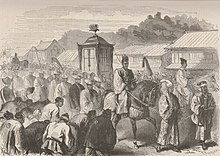A History of Japan: From Mythology to Nationhood/The Meiji Restoration
The Meiji Restoration (明治維新 Meiji Ishin) is the collective name for the events that restored imperial rule to Japan in 1868. The Restoration led to enormous changes in Japan's political and social structure, and spanned both the late Edo period (often called Late Tokugawa shogunate) and the beginning of the Meiji Era, as the country was opened to the rest of the world.

Alliances and allegiances[edit | edit source]
The formation in 1866 of the Satsuma-Chōshū Alliance between Saigō Takamori, the leader of the Satsuma domain, and Kido Takayoshi, the leader of the Chōshū domain, built the foundation of the Meiji restoration. These two leaders supported the Emperor Kōmei (Emperor Meiji's father) and were brought together by Sakamoto Ryoma for the purpose of challenging the ruling Tokugawa Shogunate (bakufu) and restoring the emperor to power. On February 3, 1867, Emperor Meiji ascended the throne after Emperor Kōmei's death on January 30, 1867. This period also saw Japan change from being a feudal society to having a capitalist economy and left the Japanese with a lingering Western influence.
Bakumatsu[edit | edit source]
During the last years of the bakufu, or bakumatsu, the bakufu took strong measures to try to reassert its dominance, although its involvement with modernization and foreign powers was to make it a target of anti-Western sentiment throughout the country.
The army and the navy were modernized. A naval training school was established in Nagasaki in 1855. Naval students were sent to study in Western naval schools for several years, starting a tradition of foreign-educated future leaders, such as Admiral Enomoto. French naval engineers were hired to build naval arsenals, such as Yokosuka and Nagasaki. By the end of the Tokugawa shogunate in 1867, the Japanese navy of the shogun already possessed eight Western-style steam warships around the flagship Kaiyō Maru, which were used against pro-imperial forces during the Boshin war under the command of Admiral Enomoto. A French military mission was established to help modernize the armies of the bakufu.
Revering the emperor as a symbol of unity, extremists wrought violence and death against the Bakufu and Han authorities and foreigners. Foreign naval retaliation in the Anglo-Satsuma War led to still another concessionary commercial treaty in 1865, but Yoshitomi was unable to enforce the Western treaties. A bakufu army was defeated when it was sent to crush dissent in the Satsuma and Chōshū Domains in 1866. Finally, in 1867, Emperor Kōmei died and was succeeded by his minor son Emperor Meiji.
Tokugawa Yoshinobu reluctantly became head of the Tokugawa house and shogun. He tried to reorganize the government under the emperor while preserving the shogun's leadership role. Fearing the growing power of the Satsuma and Chōshū daimyo, other daimyo called for returning the shogun's political power to the emperor and a council of daimyo chaired by the former Tokugawa shogun. Yoshinobu accepted the plan in late 1867 and resigned, announcing an "imperial restoration". The Satsuma, Chōshū, and other han leaders and radical courtiers, however, rebelled, seized the imperial palace, and announced their own restoration on January 3, 1868.
Shortly thereafter in January 1868, the Boshin War (War of the Year of the Dragon) started with the Battle of Toba-Fushimi in which Chōshū and Satsuma's forces defeated the ex-shogun's army. This forced (or allowed) Emperor Meiji to strip Yoshinobu of all power, setting the stage for official restoration. On January 3, 1868, the Emperor made a formal declaration of the restoration of his power: "The Emperor of Japan announces to the sovereigns of all foreign countries and to their subjects that permission has been granted to the Shogun Tokugawa Yoshinobu to return the governing power in accordance with his own request. We shall henceforward exercise supreme authority in all the internal and external affairs of the country. Consequently the title of Emperor must be substituted for that of Taikun, in which the treaties have been made. Officers are being appointed by us to the conduct of foreign affairs. It is desirable that the representatives of the treaty powers recognize this announcement."
There were many causes to the Meiji Restoration. The Japanese knew that they were behind the rest of the world when American Commodore Matthew C. Perry came to Japan to try and issue a treaty that would open up Japanese ports to trade. Perry came to Japan in large warships that far outdated any Japanese ship at the time. The leaders of the Meiji Restoration, as this revolution came to be known, acted in the name of restoring imperial rule. The word "Meiji" means "enlightened rule" and the goal was to combine "western advancements" with the traditional, "eastern" values. The main leaders of this were: Ito Hirobumi, Matsukata Masayoshi, Kido Takayoshi, Itagaki Taisuke, Yamagata Aritomo, Mori Arinori, Okubo Toshimichi, and Yamaguchi Naoyoshi. However, political power simply moved from the Tokugawa Shogun to an oligarchy consisting of these leaders, mostly from the Satsuma Province (Okubo Toshimichi and Saigō Takamori), and the Chōshū province (Ito Hirobumi, Yamagata Aritomo, and Kido Takayoshi). This reflected their belief in the more traditional practice of imperial rule, whereby the emperor performs his high priestly duties and his ministers govern the nation in his name.